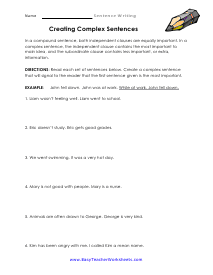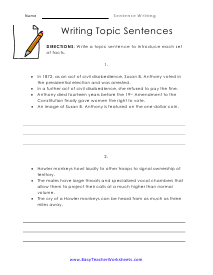Crafting a well written sentence takes a great deal of patience due to the attention to detail that is required and the amount of experience that is needed to make certain the rules of grammar are followed. The use of words is important, but what is paramount is the arrangement of those words and the words that support it. When the time comes for your class to implement the grammar techniques you have taught, the most effective way to enhance writing skills is to work through each of the modules presented below. Fifteen worksheets allow students to work at their preferred paces to match learning styles. The premise behind this set of worksheets is to apply hands on experience when learning about different types of sentence structures. You can ask your kids to take a paragraph and expound on the story the paragraph tells. Get down to the nuts and bolts of writing by gaining access to the highly rated worksheets. Practice your ability to write clear and concisely.
Printable Sentence Writing Worksheets
Click the buttons to print each worksheet and answer key.

Expanding Ideas
Follow the instructions to expand the sentence below in the various ways indicated. Think about how they work best for you.

Writing Sentences
Expand each sentence below into a complex form, using the subordinating conjunction in parentheses.

A Bit Complex
Change each concept that is set in motion to a more complex version. This will require you to think through everything.

Writing Topic Sentences
Choose five of the topics below. Write a solid topic sentence for each topic that you choose.

Make Writing Simple
There are four kinds of sentences in the English language. The structure for each type can differ in verb tense, word order and in punctuation.

Creating Complex Thoughts
Read each set of sentences below. Create a complex sentence that will signal to the reader that the first sentence given is the most important.

Writing Cleft Sentences for Effect
On a separate sheet of paper, create sentences based on the sentence below that emphasize different aspects of it. They should has amain clause and a dependent clause.

Original Writing
Write 5 original thoughts as indicated below. You should take some thinking time before writing.

Expanding with Details
Use the hints in parentheses to add detail and expand the sentences below. This will allow you to find your inner voice.

Writing Topics
Write a topic sentence to introduce each set of facts. Then go from there. This will make you pause for a minute.

Writing Concluding Sentences
Write a series of your concluding thoughts for each paragraph that is provided for you.

Writing Interrogatives
Some sentences make a statement. Others ask a question. Rewrite each of these below so that it asks a question.

What Is Happening?
Write a statement to describe what is happening in each picture. This is a great opportunity for you to be creative with your language.

My Response Is...
Write a complete thought to respond to each prompt. Make sure to outline it, before you write it.

Best Treehouse Ever!
Look at the picture. Then write five well crafted sentences that describe the treehouse.
How to Write a Complete Sentence?
Grammar can be confusing since there are so many rules to follow. Basic language features like a complete sentence can elude some people, and even seasoned writers can sometimes skip out on essential rules. If you are one of those people, here is a full guide on how to write craft complete thoughts in sentence form.
What Does a Complete Sentence Comprise of?
A full sentence is a collection of words that expresses a complete thought. At least one predicate and subject, the required components of independent clauses, must be present to form a complete sentence. The subject, which includes a noun, is the initial information unit, while the predicate, which includes a phrase or verb, builds on that information. You need to use a capital letter to begin your sentence, and it should end with an exclamation point, question mark, or period.
How to Write Them
Start with your main subject when you are creating a full sentence. The topic of the sentence expresses what or who the statement is about. Then, after the subject, add a predicate that provides information on what the subject is doing or any other additional info. Predicates, which normally start with a verb, may also use a linking verb to connect the subject to a verb or noun.
Short or long sentences can include compound or complex sentences and declarative, exclamatory, or interrogative sentences. Full phrases, in whatever form, communicate a complete notion. Check out the following full sentence form examples:
The jewel thief had an affinity for rubies.
The main noun or subject in this sentence is "The jewel thief," while the predicate for the sentence is "has an affinity for." The predicate describes more details about the subject.
My friend is amazing at sketching, but I don’t even know how to draw a stickman properly.
The sentence above has two subjects that are connected under one single idea: the ability to draw both subjects. It is a compound sentence with two clauses that are separated by punctuation –the comma. The first clause uses the main verb, "has," as a predicate for the friend. The second uses the word "know" as the main verb for the writer.
Every time Jane watches a sad film, she cries, which is why she avoids movies with sad endings.
An independent clause is used in this sentence, "Every time Jane watches a sad film, she cries." The dependent clause is "which is why," which highlights more details about the writer.
Before you complete a sentence, start by outlining the thoughts you are trying to get across and the goal of the sentence. Is it written to make a person act, feel something, or just understand something? These are the questions you need to ask yourself. The series of sheets you will find below will run you through all the different types of sentences that you will need to tackle. Take your time and focus on the message that you are trying to get out to your audience.
Incomplete, Complete, and Run-on Sentences
Whether the sentence is run-on, incomplete, or complete, they all convey an idea with varying levels of detail.
Complete: A full sentence expresses an entire idea or thought. The main clause plus a predicate are required to make a complete sentence.
Incomplete: Sentence fragments contain some info but are incomplete in and of themselves. "Moved north," for example, is an ambiguous statement due to the absence of a defined topic. The reader would understandably wonder "what" or "who" traveled north. Prepositional terms like "before" or "although" are often used to start fragments.
Run-ons: Run-ons include an excessive amount of information. Run-on statements are usually extensive and include several topics rather than a single core topic. Comma splices may also be seen in run-on sentences. Rather than connecting a subordinate phrase to the main clause, the comma connects two ideas that might be better articulated as distinct sentences.
Now that you have learned how to write a complete sentence, you can get back to writing without an issue!

